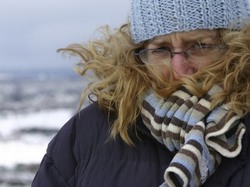
Cold is rightly regarded by many workers as a hazard. Lowering of temperatures either outdoors or indoors causes not only general physical discomfort, but a loss of dexterity, energy and alertness. It can also lead to severe physical damage and death.
The body comfort and safety of cold weather workers is dependent upon three major factors:
Cold temperatures and the human body’s responseA cold climate has been defined in a number of ways, ranging from the temperature below 10°C1 to temperatures below room temperature (approximately 22°C2). For worker, safety it’s sensible to say that the sensation of cold is an accurate indication of coldness and the danger from cold.
Thermoregulation is the human body’s ability to regulate heat production by releasing body heat at the same rate it is produced. Blood circulation and conduction pass heat from within the body to the surface.
Blood vessels can dilate or constrict to vary the flow of blood to surface tissues. Heat is passed through the body and conducted out through clothing, can be affected by air currents. The evaporation of water vapour from the skin and respiratory tract also affects the regulation of heat production and loss. Temperature changes, physical activity and clothing all affect and alter this regulatory process in different ways.
Cold weather forces the loss of heat from the body. In order to increase the insulation and thus maintain the temperature of the inner body, the flow of blood to the skin is reduced. This causes loss of feeling and numbness in the extremities (fingers, toes, nose, ears).
A small temperature drop in the body core produces shivering. Shivering is the body’s protective mechanism of rapid muscle movement, which generates heat to help maintain inner body temperature. Shivering,numbness and discomfort are warnings that the body must be warmed by a warmer environment, by more vigorous physical activity or by increased insulation from the cold. As will be seen, these protective measures can themselves present their own hazards in cold weather.
Cold temperatures and wind chillOne of the most important, but often overlooked, considerations in cold weather work is the effect of wind combined with air temperature. The “wind-chill factor” can account for about 80 per cent of the total heat loss from the body.
Different combinations of air temperature and wind speed can present the same hazards. For example, when the air is calm and the temperature is 1°C, the body will feel cool. The same temperature with 40 km/h winds can produce bitter coldness. The wind blows away the thin layer of air that acts as an insulator between the skin and the outside air.
The body comfort and safety of cold weather workers is dependent upon three major factors:
- climatic conditions,
- body heat and water vapour production,
- the entire assembly of clothing.
Cold temperatures and the human body’s responseA cold climate has been defined in a number of ways, ranging from the temperature below 10°C1 to temperatures below room temperature (approximately 22°C2). For worker, safety it’s sensible to say that the sensation of cold is an accurate indication of coldness and the danger from cold.
Thermoregulation is the human body’s ability to regulate heat production by releasing body heat at the same rate it is produced. Blood circulation and conduction pass heat from within the body to the surface.
Blood vessels can dilate or constrict to vary the flow of blood to surface tissues. Heat is passed through the body and conducted out through clothing, can be affected by air currents. The evaporation of water vapour from the skin and respiratory tract also affects the regulation of heat production and loss. Temperature changes, physical activity and clothing all affect and alter this regulatory process in different ways.
Cold weather forces the loss of heat from the body. In order to increase the insulation and thus maintain the temperature of the inner body, the flow of blood to the skin is reduced. This causes loss of feeling and numbness in the extremities (fingers, toes, nose, ears).
A small temperature drop in the body core produces shivering. Shivering is the body’s protective mechanism of rapid muscle movement, which generates heat to help maintain inner body temperature. Shivering,numbness and discomfort are warnings that the body must be warmed by a warmer environment, by more vigorous physical activity or by increased insulation from the cold. As will be seen, these protective measures can themselves present their own hazards in cold weather.
Cold temperatures and wind chillOne of the most important, but often overlooked, considerations in cold weather work is the effect of wind combined with air temperature. The “wind-chill factor” can account for about 80 per cent of the total heat loss from the body.
Different combinations of air temperature and wind speed can present the same hazards. For example, when the air is calm and the temperature is 1°C, the body will feel cool. The same temperature with 40 km/h winds can produce bitter coldness. The wind blows away the thin layer of air that acts as an insulator between the skin and the outside air.
